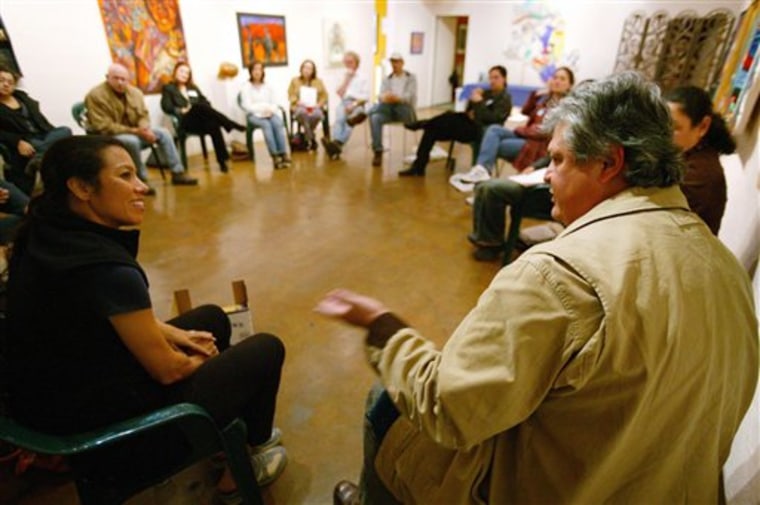In the cutthroat competition to get their kids into a public magnet school, some parents are turning to support groups and a stiff drink to help them through the process.
The support groups are for commiserating and to share tips on finishing a deceptively complex one-page application. The drinks, jokes one parent, are to numb the pain.
"You just want to break down weeping because you can't make sense of it," laments writer and performer Sandra Tsing Loh.
Loh organizes meetings called "Martinis and Magnets" based on her experience as a parent traumatized by the year she spent getting her young daughter into kindergarten.
Applying for a magnet school is a common theme among many middle-class parents in large districts across the country this time of year. It's usually not simple, and admissions criteria vary by city.
For schools geared to gifted kids, admission is based on academic merit. For regular magnet schools, it's usually a lottery-based system that weighs factors like race.
In Los Angeles, for example, higher points go to applicants who live near an overcrowded school with a large minority population. A racially weighted lottery is used for magnets in Chicago.
The magnet school handbook
In New York City, which offers the most varied educational choices for parents in the country, a thick book written by a former reporter is available to guide parents through the confusing maze of public schools.
Strategizing is important when it comes to getting into the best-performing magnet schools, and it can take several years to finally break through.
Last year, the Los Angeles school district received 56,414 applications for 162 magnet schools. About 23 percent, or 12,932 students, were given spots.
One purpose of most magnet schools is integration. In Los Angeles, 30 percent of the slots are reserved for white students, said Donnalyn Anton, executive officer of education services for the Los Angeles Unified School District.
During the past year, officials have tried to simplify the magnet school booklet that describes the labyrinth of schools and the process of applying. Parents, including Loh, were enlisted to help make it clearer.
"We're not trying to make it something that will confuse people," Anton said.
More than a year ago, Loh and Christie Mellor, a fellow public school parent and the author of "The Three-Martini Playdate," came up with the idea of holding the seminars.
A small menu of educationally themed drinks is served at the meetings to help relax "sleep-deprived, hysterical parents," Loh said. One such drink is the "Roy Romer," named for the former Los Angeles schools superintendent — a splash of candied ginger vodka with cranberry juice.
For this year's first meeting, more than 100 parents crammed into a small art studio. The expectation was to have a relaxed, casual affair, but the issues that surfaced were anything but.
'A year of madness'
A childless couple said they were thinking about having kids. One mom wondered if she should be testing her baby now. A dad with a Ph.D. couldn't figure out the lottery system, which is based on accumulating points.
Loh herself said she went through "a year of madness."
When her daughter was almost ready for kindergarten, Loh wasn't keen on the local neighborhood school because of negative perceptions about it fueled by other parents. But shelling out big bucks for a private school was not an option either.
She enrolled her daughter at the local school after seeing it for herself, but then a slot opened at a magnet school and Loh started her there instead.
Mellor's oldest son attends one of the most prestigious magnet high schools in the city, The Los Angeles Center for Enriched Studies.
He got lucky, she readily admits. He had been on the waiting list but just as the family was about to leave on a summer vacation, the school called. It had a spot for him.
Mellor thinks if they had missed that call, it's likely her son never would have gotten in.
Too exclusive?
Eileen Kugler, a Virginia parent who wrote "Debunking the Middle-Class Myth: Why Diverse Schools Are Good for All Kids," said she applauds the effort but wonders if such cocktail parties might exclude some immigrant and low-income parents who may need more help.
"Once you name something 'Martinis and Magnets' you make it somewhat exclusive," she said. "It's going to attract a particular type of parent."
But Loh thinks it's the pushy, neurotic middle-class parents who will ultimately lead the drive to help improve public schools. When that happens, the upside is that all students benefit, she says.
A couple of weekends ago, a meeting held at an art studio was more discussion-oriented and not so nuts and bolts as in previous gatherings.
Still, acronyms and the jargon beloved by education bureaucrats were freely tossed around by parents in the know.
But not everyone there was in the know.
"This is confusing," Kim Smith said with a sigh as her 4-year-old bounced around next to her.
